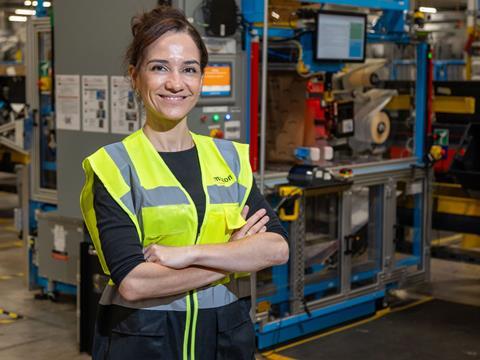
Last month, Amazon announced that 100% of its delivery packaging in Europe is now recyclable – including for products sold by third parties on its site. Thais Blumer, the company’s European Head of Sustainable Packaging, tells us more about this move – as well as Amazon’s overall packaging sustainability ethos.
First things first: could you introduce this announcement to our readers who may have missed the initial story?
Sure. Amazon announced that all its delivery packaging in Europe—the boxes, bags and envelopes needed to get products to customers—is now recyclable. This includes items sold by Amazon, and third-party selling partners that use Fulfilment by Amazon (FBA). Customers are receiving packages in flexible paper bags, cardboard envelopes and corrugated cardboard boxes, which are easily recyclable in household recycling across Europe.
In the past year, Amazon has also grown the number of products shipped without any additional Amazon packaging by more than 50% in Europe. These combined initiatives mean the company estimates it has avoided using more than 1 billion single-use plastic delivery bags from its European distribution network since 2019.
Why did Amazon arrive at the decision to use 100% cardboard/paper-based packaging? And in terms of carbon emissions throughout their entire life cycle, how do these products compare with the previously-used plastic solutions?
We know customers care about the packaging used to ship their Amazon orders. Customers want orders delivered in right-sized, easily recyclable packaging that makes sure the product arrives in great condition, and minimizes its impact on the environment.
At Amazon, we care deeply about our packaging achieving both of these goals, and we have teams of scientists and other experts who are constantly working to reinvent how products are shipped for the good of customers and the planet.
We leverage a variety of packaging options globally for product shipping to optimize for strong durability, lightweight, and optimal size. While single-use plastics are lightweight, waterproof, and generally result in lower carbon emissions to be shipped, they are difficult to recycle, so are more likely to create waste in the long term.
Furthermore, single-use plastics generally require our customers to take the materials from their homes to store drop-off locations. As a company that obsesses about our customers, we recognize it’s not the easiest customer experience. This has created a challenge that Amazon is taking head-on—how to continue to find ways to minimize carbon emissions, increase recyclability, and reduce waste.
Since 2015, we have reduced the average weight of the packaging per shipment by 41% and eliminated the use of more than 2 million tons of packaging materials.
Some products are now also being shipped with just an address label added. Are you at all concerned about product damage in this context, and how would you respond to critics who might argue that packaging saves more C02 emissions than it produces by performing the essential role of protecting the product?
Our Ships In Product Packaging programme (SIPP) encourages Selling Partners to package their products in easy-to-open packaging that is recyclable and ready to ship to customers without additional Amazon packaging. Products are shipped with just an address label added.
This allows us to eliminate unnecessary packaging altogether and reduce the weight of deliveries. In order to prevent damage, we test packaging in a dedicated, state-of-the-art lab and in fulfilment centres across the globe to ensure products are protected all the way to the customer’s doorstep.
We were interested to read that Amazon is implementing incentives for selling partners to reduce their packaging across its value chain. How does this work in practice?
The SIPP programme has several benefits. It helps sellers connect with customers. Customers will immediately see their branding upon delivery, and packaging designed for e-commerce typically provides an easy-to-open packaging that creates less waste.
It can also reduce costs. Products certified to ship in their own packaging can be eligible for lower FBA fulfilment fees. Additionally, selling partners can save on the cost of the packaging itself. Retail packaging tends to be oversized and glossy to capture customer attention. Designing packaging for e-commerce, where the customer is able to see images of the product online, allows for simpler, and often lower-cost packaging.
By using more compact packaging, selling partners can potentially reduce transportation costs and carbon emissions by using less packaging material and taking up less space on trucks, which means fewer trips.
Amazon uses an in-house, machine learning-assisted method to determine the type of packaging needed. Could you give us some more information on this?
With millions of products and an infinite number of order combinations, identifying the optimal packaging size to keep each unique order safe during transit represents a significant challenge. We use machine learning algorithms to determine the best packaging solution for each order we fulfil. These cutting-edge algorithms help reduce empty space in packages.
Computer vision and natural language processing guide our system to pinpoint the optimal packaging type for each item—from bag to box—depending on the level of protection needed. Where possible, we use lightweight packaging by prioritizing flexible paper bags and envelopes, which are up to 90% lighter than similar-sized, rigid corrugate boxes. Over the past five years, these algorithms have reduced the use of cardboard boxes by over 35%.
To what extent was this move motivated by the incoming Packaging and Packaging Waste Regulation? It would also be great if you could let us know more about Amazon’s general feelings on the PPWR.
At Amazon, we support the European Commission’s goal to tackle excessive packaging and packaging waste in online sales, via legislation such as the Packaging and Packaging Waste Regulation. We continue to invest in the SIPP programme as we believe packaging designed for e-commerce is key to achieving this.
If you liked this article, you might also enjoy:
The L’Oréal approach to packaging sustainability
The way we talk about plastic needs to change – here’s how to get it right
What steps is Apple taking to make its packaging more sustainable?

















No comments yet